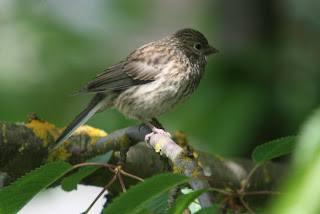When we moved into this house -- last summer -- there were pigeons in our attic.
 |
| Timmy's "parents" -- at least the seemed to be caring for him when we moved in. |
We didn't know it was pigeons at first -- we thought it might be squirrels --but observation soon confirmed a family of pigeons. Sexing pigeons is way beyond my ability, but I assumed (because there were three of them nesting together instead of roosting with a flock, and because two of them seemed to be closer to each other) that it was mated pair and offspring. They were beautiful birds. The pigeons out here in West Seattle look much healthier than the birds downtown. Sleeker, more fit, and their colors are brighter. They are also wilder. Pigeons downtown are so acclimated to humans that they come right up to you like aggressive panhandlers -- I once had a pigeon try to take a sandwich out of my hands. But out here they keep their distance and act like wild birds (which they really aren't).
 |
| These pigeons seemed like a couple, and seemed to be taking care of Timmy. |
It was the third pigeon that was most interesting -- the one I assumed was the offspring. Like the others, he was a good looking bird. But he was a bit odd. In the evenings I often saw him flying around the house, sitting on the deck, approaching all the windows and trying to get in. He would even peck at the glass. I was afraid that he might fly into a window and hurt himself. He seemed unsure about where he wanted to go or what he was doing. And because he seemed a little --- well, handicapped -- we named him Timmy. (South Park fans will understand.)
But the pigeons were really a little bit of a nuisance. They started raiding my bird feeders -- which upset the chickadees, who would sit on the branches and scold them (or scold me for not stopping them, I'm not sure which). Also, there were concerns about damage to the house and contamination -- since they were nesting right over our kitchen. We decided that the pigeons had to go.
So, during the daytime, when the birds were usually gone anyway, my roommate climbed up in the attic and made sure it was empty, and the landlord's maintenance guy sealed up the hole. After that, we didn't see the birds anymore and I assumed that, finding their nesting place sealed, they had moved on. (There are a lot more pigeons just a few miles south of here in the commercial area of White Center).
Except, a day or two later (like something in a Poe story), we heard scratching in the attic again. Could it be that there actually were squirrels up there, and they had another entrance? Squirrels are much better and getting into small spaces than pigeons. After about three or four days we called the maintenance man and he went up into the attic to check it out again.
And found Timmy.
 |
| Timmy is really a beautiful bird -- just a little odd. |
Somehow, we had missed the poor guy when we secured the attic, and he'd been trapped up there for almost a week. We felt awful. The maintenance man captured him and brought him down. He seemed very confused and disoriented. He stumbled around our yard for a while, then sat on the roof of a neighbor's shed for several hours. We put water up there hoping he would drink it. I was preparing to try to capture him and take him to the wildlife rehab center. But, finally, he flew away.
And we didn't see him much all winter.
There really weren't any pigeons around our neighborhood after that. Every once in a while I would think of Timmy and hope he was doing well. (For some reason, I didn't worry about the other two -- they seemed like capable birds to me. I was sure they'd be okay.)
And then, early this spring, Timmy showed up again. He went back to perching on the drain outside the kitchen. He was looking good, but he still acted a little odd. Timmy seemed to be looking for his old home. Pigeons, after all, are legendary for their homing skills, and even a -- well, handicapped -- bird like Timmy could easily find his way back to the place where he was hatched.
 |
| Timmy! |
He's been hanging around consistently ever since. I don't know if he flies off at night and joins other pigeons in the roost, but he's frequently here late in the evening and early in the morning. I've started putting food out for him on the rail (which is also popular with Juncos, House Sparrows, and House Finches and -- I'm afraid -- rats). I'm trying to teach my dog, Lulubelle, not to bark at Timmy when he comes to eat. She is dubious.
For now, Timmy has sort of become part of our family.
Birdland West readers will be interested in my review of Feathers: The Evolution of a Natural Miracle by Thor Hanson, which is posted now at Books and Beasts. It's a great book and a must read for all bird lovers. Check out the review here.
(Many of the original photographs featured on Birdland West are available for sale as art quality prints. You can check out all of our offerings at http://AlexWashoe.imagekind.com. If you see an image here that does not show up on our Imagekind site please contact me directly and I'll let you know about availability.)






















